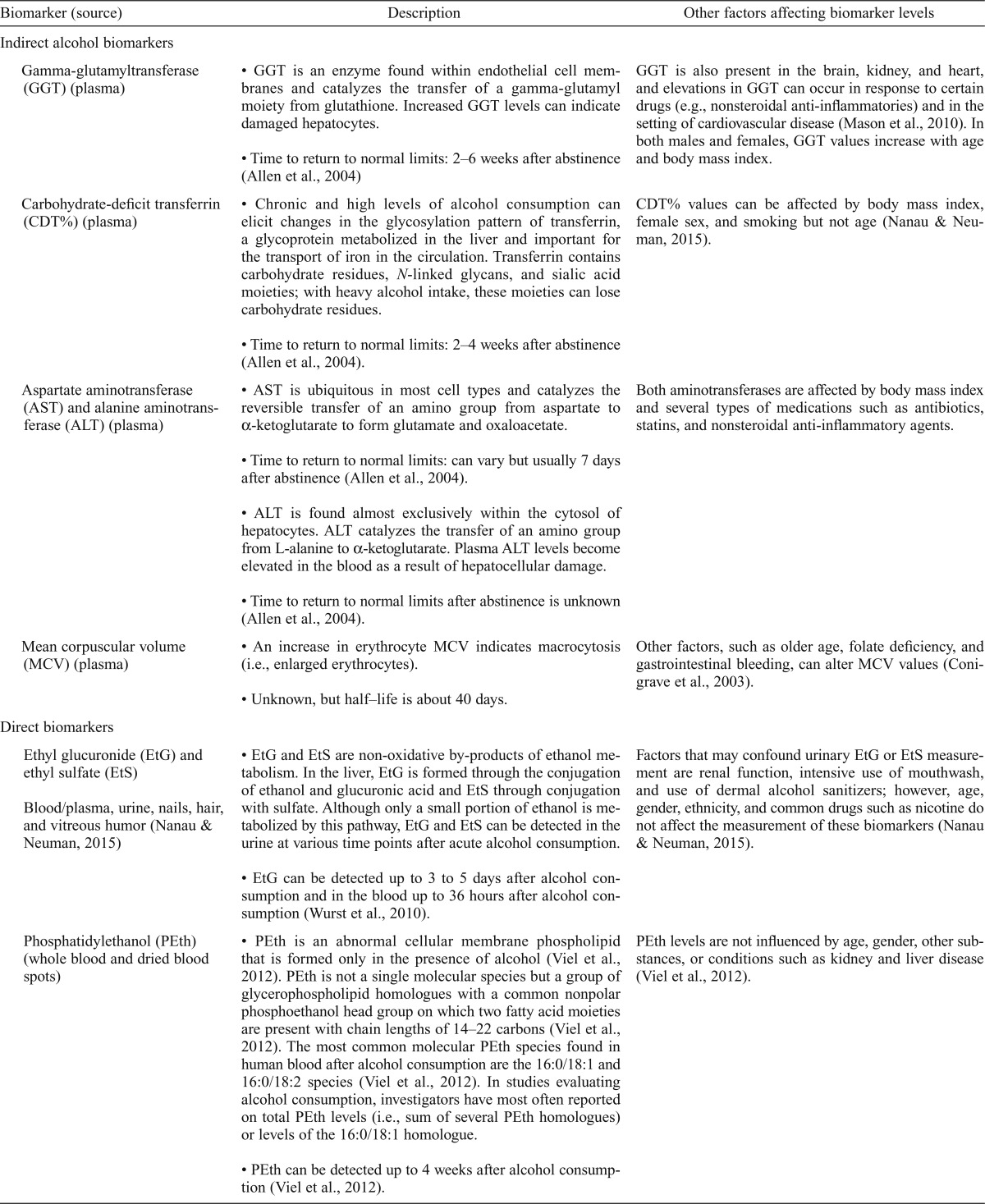Table 3.
Biomarker description
| Biomarker (source) | Description | Other factors affecting biomarker levels |
| Indirect alcohol biomarkers | ||
| Gamma-glutamyltransferase (GGT) (plasma) | • GGT is an enzyme found within endothelial cell membranes and catalyzes the transfer of a gamma-glutamyl moiety from glutathione. Increased GGT levels can indicate damaged hepatocytes. | GGT is also present in the brain, kidney, and heart, and elevations in GGT can occur in response to certain drugs (e.g., nonsteroidal anti-inflammatories) and in the setting of cardiovascular disease (Mason et al., 2010). In both males and females, GGT values increase with age and body mass index. |
| • Time to return to normal limits: 2–6 weeks after abstinence (Allen et al., 2004) | ||
| Carbohydrate-deficit transferrin (CDT%) (plasma) | • Chronic and high levels of alcohol consumption can elicit changes in the glycosylation pattern of transferrin, a glycoprotein metabolized in the liver and important for the transport of iron in the circulation. Transferrin contains carbohydrate residues, N-linked glycans, and sialic acid moieties; with heavy alcohol intake, these moieties can lose carbohydrate residues. | CDT% values can be affected by body mass index, female sex, and smoking but not age (Nanau & Neuman, 2015). |
| • Time to return to normal limits: 2–4 weeks after abstinence (Allen et al., 2004). | ||
| Aspartate aminotransferase (AST) and alanine aminotransferase (ALT) (plasma) | • AST is ubiquitous in most cell types and catalyzes the reversible transfer of an amino group from aspartate to α-ketoglutarate to form glutamate and oxaloacetate. | Both aminotransferases are affected by body mass index and several types of medications such as antibiotics, statins, and nonsteroidal anti-inflammatory agents. |
| • Time to return to normal limits: can vary but usually 7 days after abstinence (Allen et al., 2004). | ||
| • ALT is found almost exclusively within the cytosol of hepatocytes. ALT catalyzes the transfer of an amino group from L-alanine to α-ketoglutarate. Plasma ALT levels become elevated in the blood as a result of hepatocellular damage. | ||
| • Time to return to normal limits after abstinence is unknown (Allen et al., 2004). | ||
| Mean corpuscular volume (MCV) (plasma) | • An increase in erythrocyte MCV indicates macrocytosis (i.e., enlarged erythrocytes). | Other factors, such as older age, folate deficiency, and gastrointestinal bleeding, can alter MCV values (Conigrave et al., 2003). |
| • Unknown, but half–life is about 40 days. | ||
| Direct biomarkers | ||
| Ethyl glucuronide (EtG) and ethyl sulfate (EtS) | • EtG and EtS are non-oxidative by-products of ethanol metabolism. In the liver, EtG is formed through the conjugation of ethanol and glucuronic acid and EtS through conjugation with sulfate. Although only a small portion of ethanol is metabolized by this pathway, EtG and EtS can be detected in the urine at various time points after acute alcohol consumption. | Factors that may confound urinary EtG or EtS measurement are renal function, intensive use of mouthwash, and use of dermal alcohol sanitizers; however, age, gender, ethnicity, and common drugs such as nicotine do not affect the measurement of these biomarkers (Nanau & Neuman, 2015). |
| Blood/plasma, urine, nails, hair, and vitreous humor (Nanau & Neuman, 2015) | ||
| • EtG can be detected up to 3 to 5 days after alcohol consumption and in the blood up to 36 hours after alcohol consumption (Wurst et al., 2010). | ||
| Phosphatidylethanol (PEth) (whole blood and dried blood spots) | • PEth is an abnormal cellular membrane phospholipid that is formed only in the presence of alcohol (Viel et al., 2012). PEth is not a single molecular species but a group of glycerophospholipid homologues with a common nonpolar phosphoethanol head group on which two fatty acid moieties are present with chain lengths of 14–22 carbons (Viel et al., 2012). The most common molecular PEth species found in human blood after alcohol consumption are the 16:0/18:1 and 16:0/18:2 species (Viel et al., 2012). In studies evaluating alcohol consumption, investigators have most often reported on total PEth levels (i.e., sum of several PEth homologues) or levels of the 16:0/18:1 homologue. | PEth levels are not influenced by age, gender, other substances, or conditions such as kidney and liver disease (Vieletal., 2012). |
| • PEth can be detected up to 4 weeks after alcohol consumption (Viel et al., 2012). |

